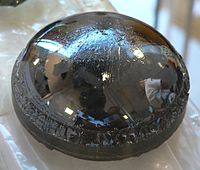
Photo from wikipedia
Waterborne polyurethane (WPU) is first used as a carbon-coating source for micrometre-sized silicon. The remaining nitrogen (N) and oxygen (O) heteroatoms during pyrolysis of the WPU interact with the surface… Click to show full abstract
Waterborne polyurethane (WPU) is first used as a carbon-coating source for micrometre-sized silicon. The remaining nitrogen (N) and oxygen (O) heteroatoms during pyrolysis of the WPU interact with the surface oxide on the silicon (Si) particles via hydrogen bonding (Si–OH⋯N and Si–OH⋯O). The N and O atoms involved in the carbon network can interact with the lithium ions, which is conducive to lithium-ion insertion. A satisfactory performance of the Si@N, O-doped carbon (Si@CNO) anode is gained at 25 and 55°C. The Si@CNO anode shows stable cycling performance (capacity retention of 70.0% over 100 cycles at 25°C and 60.3% over 90 cycles at 55°C with a current density of 500 mA g−1) and a superior rate capacity of 864.1 mA h g−1 at 1000 mA g−1 (25°C). The improved electrochemical performance of the Si@CNO electrode is attributed to the enhanced electrical conductivity and structural stability.
Journal Title: Royal Society Open Science
Year Published: 2018
Link to full text (if available)
Share on Social Media: Sign Up to like & get
recommendations!